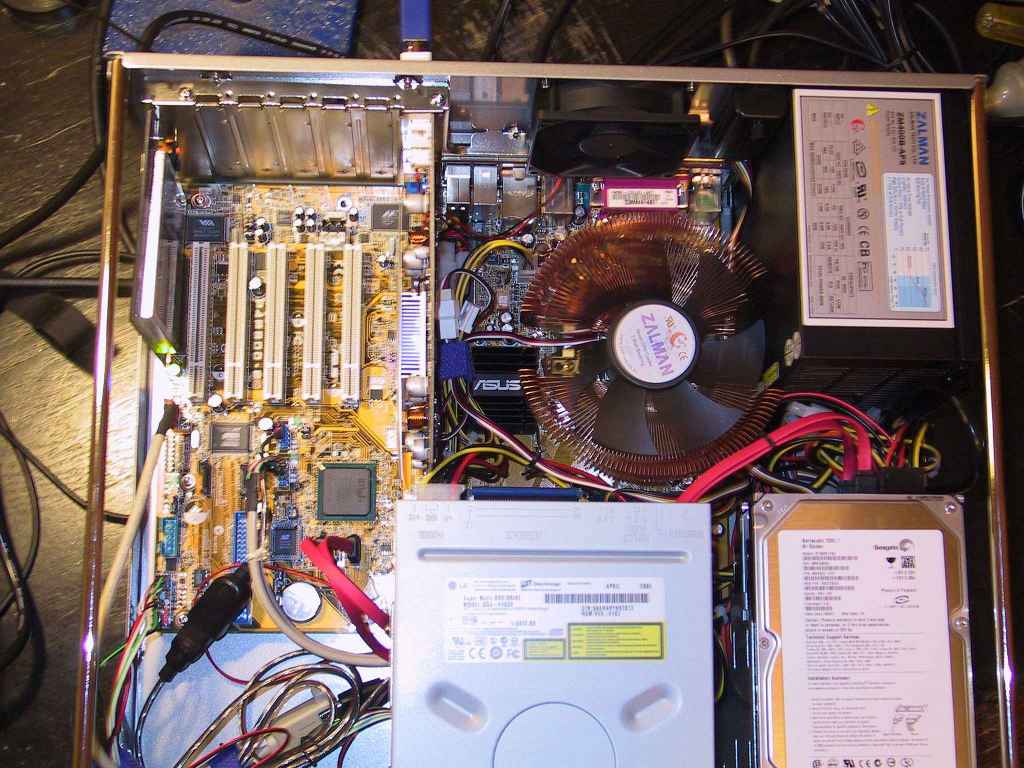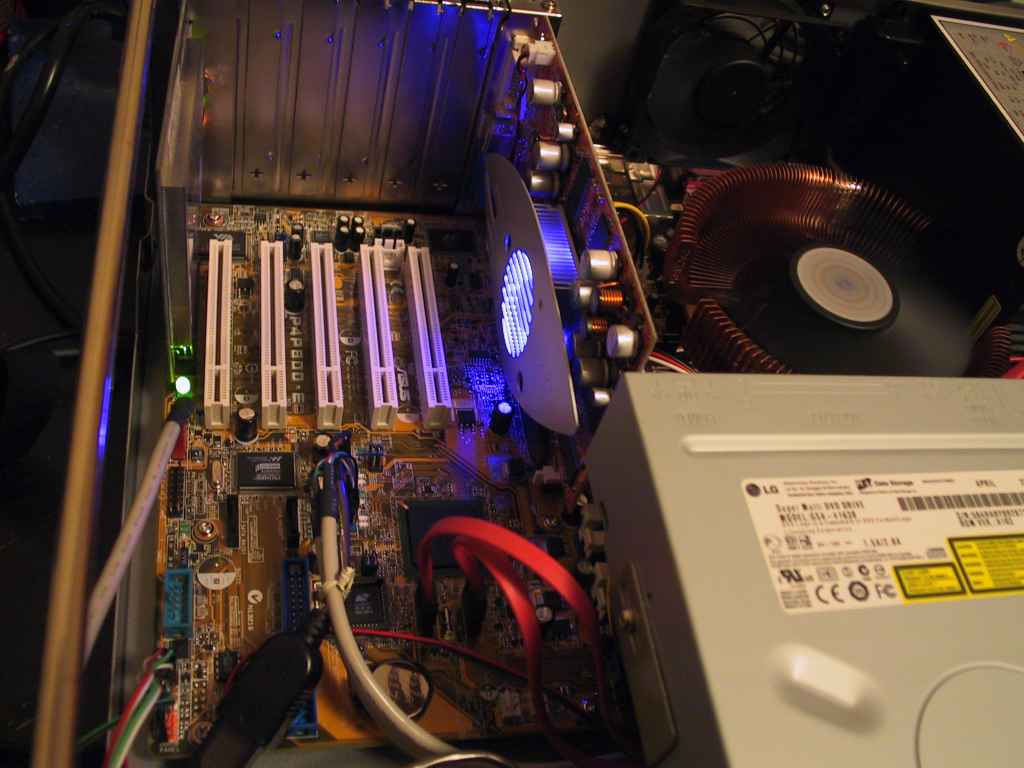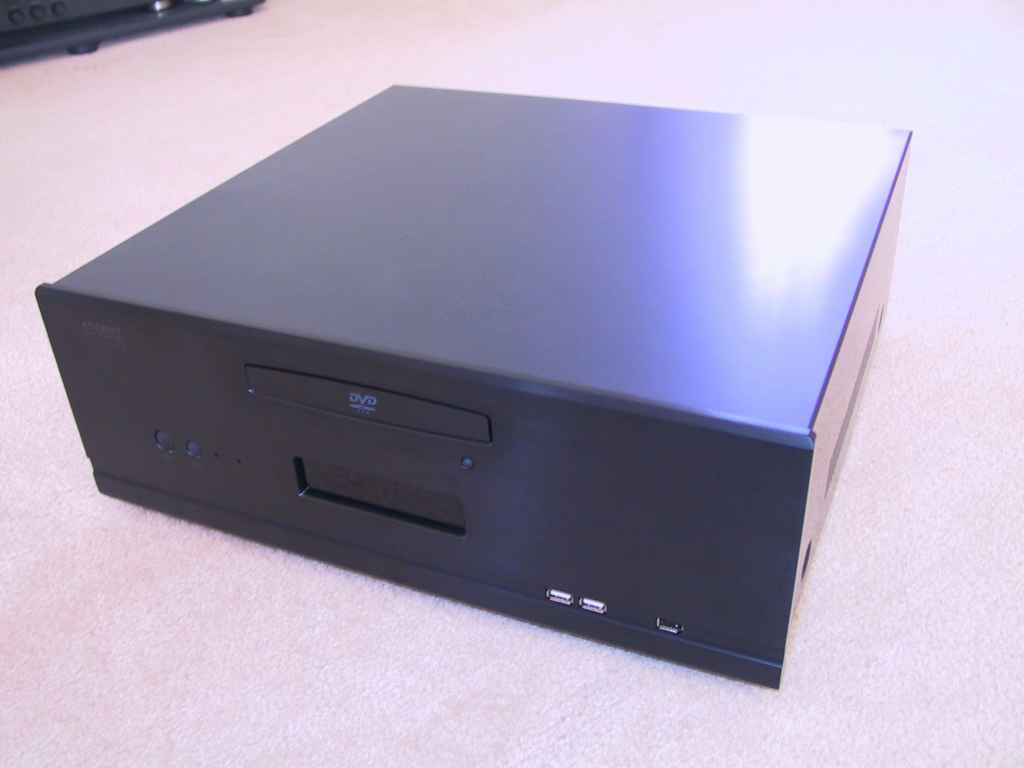
I'd always wanted a PC dedicated to playing media files and recording TV, with plenty of hard disk storage so I wouldn't have to worry about purging files on a weekly basis. The advent of Digital TV and cheap HDDs plus finally getting broadband (to watch internet TV) got me motivated to get something together. The clincher came when I saw the Accent HT400 case.
Accent HT400 ATX
Home Theatre PC Case (black) - includes iMon remote control and VFD. This was
bought along with most of the other bits from Maco
Technology.
ASUS P4P800E Deluxe motherboard
Pentium 4 (Prescott) 3.0GHz
1GB RAM (2xCorsair PC3200)
2 Seagate SATA Barracuda NCQ drives
(80GB for the OS/music drives and a 300GB dedicated
for video).
Asus wifi-b wireless lan card (taken from my main PC)
Abit R9600XT AGP video card
Zalman CPU Cooler CNPS7700 (pure copper version)
Zalman 400W ATX Power Supply
DVICO Fusion DVB+ DIgital TV Tuner card (since upgraded to 2 of these)
LG 16x dual layer DVD burner
Wireless Logitech keyboard and mouse
WinXP Home
iMon software (for the VFD and remote control), iMedian
Winamp (MP3 playback)
Zoomplayer (a very flexible and configurable media player)
PowerDVD 5 (came with the video card)
DVB Webscheduler (schedules recordings, rule based program selection)
DVICO player (for rare cases where I use it to watch TV live)
Nero 6 ReLoaded (note: 5.5 doesn't support the burner)
Windows Media Encoder 10 (used to recompress/stream programs over the WLAN/Internet)
VNC (for administration)
Apache Web Server and FileMan.php (for remote file retrieval)
There are other sites on installing with the Accent HT400 so I wont focus on that here.
The case front panel includes a fluorescent display (VFD) and remote control IR sensor, power and reset buttons, power and HDD LEDs and 2 USB and 1 Firewire (1394) connectors. Internally its basically an ATX PC crammed into a tiny space. The main thing I had to watch was the Video Card and CD-ROM drives, which must be chosen carefully to fit the case. A neat thing about the case is that you can turn the PC on/off from the remote control.
There are bundles of cables as plenty of length is supplied to wire the FireWire and VFD display out to the back connectors of the case. With the ASUS motherboard, this wasn't necessary as it has internal USB and Firewire connectors. I took the firewire connector off the plate (its supplied with the motherboard) so it all could stay internal.
Under the CDROM drive is tucked its data ribbon connector and the 2 hard drives have lots of power wires under them. The power supply doesn't wire straight to the motherboard but rather to a break-out connector so the front panel display can continue to receive power when the PC is off.
The CPU cooler I bought is monstrous and a few of the fins had to be trimmed so they wouldn't press against the power supply. It came with a fan speed controller (which I've mounted next to the left rear corner of the power supply). I'm able to keep the fan at a very moderate speed and it provides plenty of cooling airflow for the Northbridge and the drives. It will be interesting to see how it copes during summer when it gets hot and humid here.

The video card fan glows a purdy blue colour. Not much point in a case like this. The card is a little overkill for watching video but I wanted the system capable of playing games since its now the one connected to the projector. Being used to the video clarity from a Matrox Parhelia, I was a bit apprehensive when I hooked it up to the projector for the first time, but I wasn't disappointed.
Note - I hadn't installed the DVICO card when I took these pictures. The SATA cables (red) certainly help reduce clutter compared to ATA IDE ribbons of the past.

And heres the front panel shortly after bringing the system up with the iMon VFD software installed. Notice the custom plate (which comes with the case) fitted to the DVD's tray (after unclipping its existing faceplate). I chose a drive with a black tray.
The display cycles through a number of status and news displays, which can be configured in the iMon software.

With the cover on, it doesnt look like the average PC...

... until you look at the back. Notice I now have the DVICO DVB+ Digital TV card installed. The P4P800E has proved a great motherboard for this system; plenty of spare USB ports and adequate audio capabilities. Notice the second fan, which was preinstalled in the case.

Network: Since the HTPC is right next to the ADSL/wireless router, its connected with CAT5 cable so I can transfer files at full speed between the HTPC and the my main PC. The wireless card came in useful when I was setting up the HTPC on the bench.
Audio: The motherboard supports 8 channel sound but I've connected it to my Yamaha surround amp with a single SPDIF cable connected to the motherboard's onboard digital out. Switching between stereo and AC3 audio sources works great with the P4P800E; when I tried the DVICO card in my main PC (which has a P4P800 board with 5.1 sound), it tended to mute stereo audio sources after you played an AC3 source.
Mouse/Keyboard: Wireless logitech desk set (black of course) but I tend to use VNC to administer and the iMon Pad remote control's mouse/arrow key modes when I need to navigate.
Video: Connects to the projector with a 10m s-video cable. This is soon to be replaced by a 10m VGA cable so I can get the maximum out of the projector - a 5 year old 1024x768 Mitsubishi LCD. Sure I wont enjoy full HDTV but it will be better than what I can put over S-Video.
TV: The RF in connector on the TV card connects to a TV aerial in my house's roof cavity. I get signal quality levels ranging from 90 to 97%.
I decided to set the system up so I could quickly save and restore the OS's state. This will be great when messing with games and then wanting to get the system back to the pristine, minimalist configuration I'm trying to keep it in.
The C drive is a 15GB partition of the 80GB drive, with WinXP and Program
Files on it. I can easily fit a TrueImage backup of it onto a standard DVD-R.
The D drive is the remainder of the 80GB drive and I use it as a temporary area to
demux the MPEG streams into before they get compressed as WMVs back to the other drive
(its faster processing from one drive to another).
The E drive is the entire 300GB drive and is used as the WebScheduler data
drive. It also stores backup images of the C drive to speed up recovery should
it ever need a restore.
I didn't find one HTPC software package that supported everything I wanted (eg:HDTV playback, remote administration/scheduling, web streaming from sites requiring passwords) so instead I've created a folder of explorer shortcuts for the streaming web sites plus programmed a macro button on the remote to enter the password.
For the VFD I was planning on using LCD Smartie until I realised that the VFD shipped no longer uses the parallel port (nice; no ugly cable out to the back parallel port) but instead works directly with the iMon remote control receiver/software through its USB connection. The iMedian HTPC software that ships with iMon does look promising though its still in heavy development. The iMon remote came with profiles (and VFD connectivity) for WinAmp and works with PowerDVD and the DVICO software. It didn't take long to set up a profile for Zoomplayer (a great media player).
Webscheduler has support for suspend/hibernation so I've set the HTPC up to hibernate after 2 hours of inactivity. Webscheduler automatically wakes it when its time to record a program or update the TV program schedules.
I've recently configured the "Task" capabilities in Webscheduler to call up some simple scripts to re-encode recorded programs to WMV format for internet streaming. This should let me watch recorded programs from anywhere with a broadband internet connection, without needing any special client software to be installed apart from Media Player 9.
Finally, here's the PC in action. In this photo it was actually streaming live TV from a TV station in Korea, which is why its so chunky. The somewhat obsolete VCR and DVD player co-exist with it for now. To the right of the HTPC sits the USB connected RF receiver for the wireless keyboard and mouse.

Noise wise the system isn't too bad. The 2 hard drives tend to "beat" their hums slightly (both 7200 RPM) and there is noticeable fan noise from the video and case fan. I dont think the CPU fan is contributing that much and the PSU fan hardly needs to spin at all. In any case, the HTPC's noise is swamped by the projector fan so I'm not too fussed by it at this time.
All up the system cost about $2100 in parts and software - a big fraction of that attributed to the case - but overall I'm very satisfied with it.